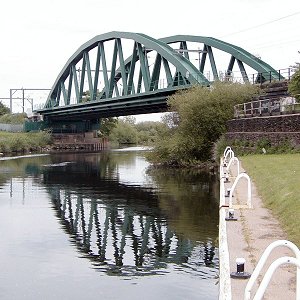Case studies
Design of pile foundations for Newark Dyke bridge (UK)
 A
Repute
analysis was undertaken for
Cementation
Foundations Skanska Ltd to assess the pile-foundation
requirements for the new railway bridge
at Newark Dyke (UK). Further details on this case study may be found in
the paper by Suckling & Lee "Piled
foundation aspects of the bridge slide at Newark Dyke" (Underground Construction 2001, Int. Symposium
& Exhibition, London, 2001, pp 361-372).
A
Repute
analysis was undertaken for
Cementation
Foundations Skanska Ltd to assess the pile-foundation
requirements for the new railway bridge
at Newark Dyke (UK). Further details on this case study may be found in
the paper by Suckling & Lee "Piled
foundation aspects of the bridge slide at Newark Dyke" (Underground Construction 2001, Int. Symposium
& Exhibition, London, 2001, pp 361-372).
The 24 piles for the south-west pile cap are 8m long, 0.6m in diameter, and in the asymmetric layout shown below. The soil profile consists of 1m of Alluvium underlain by 2m of river gravels which overlie 5m of Mercia Mudstone. The applied vertical loads result from the combined effect of live and dead loads, whereas the horizontal loads and moments in X and Y directions are generated by the trains braking and accelerating.

A Repute analysis using linear elastic and non-linear soil models has been undertaken, and results for the most heavily loaded row in the group (pile Nos 1 to 5) are compared to a previous PIGLET analysis in the table below.
| Pile axial load (kN) | ||||
| Pile No | PIGLET | Repute (linear) | Repute (non-linear) | Percentage difference between PIGLET and Repute (non-linear) |
| 1 | 2545 | 2340 | 2160 | -15% |
| 2 | 1589 | 1570 | 1590 | 0 |
| 3 | 1446 | 1450 | 1460 | +1% |
| 4 | 1502 | 1470 | 1470 | -2% |
| 5 | 2243 | 1970 | 1810 | -19% |
Piles were designed with a factor of safety of 2 on the average load and 1.5 on the maximum load in each row, as calculated by PIGLET. Thus, pile Nos 1 to 5 were designed with a minimum ultimate axial capacity of 3818kN. It is important to note that Repute predicts lower maximum and average pile loads. This results, for the non-linear soil model, in an increase in design factors of safety to 2.2 on the average pile load and 1.8 on the maximum pile load, compared to 2.0 and 1.5 originally desired from the PIGLET results.
Finally, it is worth noting that the maximum pile load calculated by structural methods was 1541kN. This is significantly lower than the maximum values obtained from the pile group analyses which consider pile-soil interaction, thereby showing the dangers of attempting to model a complex pile-soil system by means of a simple structural frame. For further details, download the report "Repute vs Structural analyses" (PDF format, size 19KB).
Acknowledgments
Appreciation is expressed to Cementation Foundations Skanska Ltd for permission to publish the above results.
References
Suckling, T. P. & Lee, J. (2001). Piled foundation aspects of the bridge slide at Newark Dyke. Underground Construction 2001, Int. Symposium & Exhibition, London, pp 361-372.
about us
consulting
software